The Impact of Wind Power Projects on Residential Property Values ...
The Impact of Wind Power Projects on Residential Property Values ...
The Impact of Wind Power Projects on Residential Property Values ...
You also want an ePaper? Increase the reach of your titles
YUMPU automatically turns print PDFs into web optimized ePapers that Google loves.
Using different statistical methods, Poletti (2005; 2007) used a t-Test to investigate Nuisance and<br />
Area Stigma by comparing the mean sales prices <str<strong>on</strong>g>of</str<strong>on</strong>g> 187 and 256 homes in Illinois and Wisc<strong>on</strong>sin,<br />
14, 15<br />
respectively, located near wind facilities (target group) to those further away (c<strong>on</strong>trol group).<br />
He split these target and c<strong>on</strong>trol groups into respective smaller and more-homogenous subgroups,<br />
such as large and small tracts, with and without homes, finding no statistical evidence<br />
that homes near the wind facilities sold for different prices than those farther away. Sterzinger et<br />
al. (2003) analyzed roughly 24,000 residential transacti<strong>on</strong>s, which were divided between those<br />
within five miles <str<strong>on</strong>g>of</str<strong>on</strong>g> a wind facility and those outside <str<strong>on</strong>g>of</str<strong>on</strong>g> five miles in an effort to assess Area<br />
Stigma. <str<strong>on</strong>g>The</str<strong>on</strong>g>y compared residential appreciati<strong>on</strong> rates over time, and found no apparent<br />
difference between those homes within and outside <str<strong>on</strong>g>of</str<strong>on</strong>g> five miles from a wind facility, but the<br />
statistical significance <str<strong>on</strong>g>of</str<strong>on</strong>g> this comparis<strong>on</strong> was not reported.<br />
Other authors have used smaller samples <str<strong>on</strong>g>of</str<strong>on</strong>g> residential transacti<strong>on</strong>s and a variety <str<strong>on</strong>g>of</str<strong>on</strong>g> simple<br />
statistical techniques, without reporting statistical significance, and have found a lack <str<strong>on</strong>g>of</str<strong>on</strong>g><br />
evidence <str<strong>on</strong>g>of</str<strong>on</strong>g> effects from Nuisance Stigma (Jerabek, 2001; Jerabek, 2002; Beck, 2004) and Area<br />
Stigma (DeLacy, 2005; Goldman, 2006). <str<strong>on</strong>g>The</str<strong>on</strong>g>se results, however, are somewhat c<strong>on</strong>trary to what<br />
<strong>on</strong>e appraiser has found. In his investigati<strong>on</strong> <str<strong>on</strong>g>of</str<strong>on</strong>g> Nuisance Stigma around a wind facility in Lee<br />
County, IL, McCann (2008) found that two homes nearby a wind facility had lengthy selling<br />
periods that, he believes, also adversely affected transacti<strong>on</strong> prices. Additi<strong>on</strong>ally, Kielisch<br />
(2009) investigated Nuisance Stigma by comparing twelve transacti<strong>on</strong>s <str<strong>on</strong>g>of</str<strong>on</strong>g> undeveloped land near<br />
two wind facilities in Wisc<strong>on</strong>sin (Blue Sky Green Field and Forward) to undeveloped land<br />
transacti<strong>on</strong>s farther away. He found that land tracts near the wind facilities sold for dramatically<br />
lower prices ($/acre) than the comparable group, but the statistical significance <str<strong>on</strong>g>of</str<strong>on</strong>g> the<br />
comparis<strong>on</strong> was not reported.<br />
In additi<strong>on</strong> to these revealed preference studies, a number <str<strong>on</strong>g>of</str<strong>on</strong>g> stated preference surveys (e.g.,<br />
c<strong>on</strong>tingent valuati<strong>on</strong>) and general opini<strong>on</strong> surveys have investigated the existence <str<strong>on</strong>g>of</str<strong>on</strong>g> potential<br />
effects. 16 A survey <str<strong>on</strong>g>of</str<strong>on</strong>g> local residents, c<strong>on</strong>ducted after the wind facilities were erected, found no<br />
evidence <str<strong>on</strong>g>of</str<strong>on</strong>g> Area Stigma (Goldman, 2006), while another found limited evidence <str<strong>on</strong>g>of</str<strong>on</strong>g> these<br />
stigmas (B<strong>on</strong>d, 2008). 17 Similarly, some surveys <str<strong>on</strong>g>of</str<strong>on</strong>g> real estate experts c<strong>on</strong>ducted after facility<br />
14 A t-Test is used to compare two sample means by discerning if <strong>on</strong>e is significantly different from the other.<br />
15 <str<strong>on</strong>g>The</str<strong>on</strong>g> 2007 study used the data c<strong>on</strong>tained in the 2005 study in combinati<strong>on</strong> with new data c<strong>on</strong>sisting <str<strong>on</strong>g>of</str<strong>on</strong>g> transacti<strong>on</strong>s<br />
that occurred in the interim period.<br />
16 C<strong>on</strong>tingent valuati<strong>on</strong> is a survey based technique to value n<strong>on</strong>-market goods (e.g., an envir<strong>on</strong>mental disamenity)<br />
that asks resp<strong>on</strong>dents what their “willingness to pay” (or “willingness to accept”) is to have, for instance, a<br />
disamenity removed from (or to have it remain in) their neighborhood. This technique is distinct from a general<br />
opini<strong>on</strong> survey, which might ask whether resp<strong>on</strong>dents believe property values have been impacted by an<br />
envir<strong>on</strong>mental disamenity and, if so, “by how much.” Although there are important distincti<strong>on</strong>s between the two<br />
techniques, with the c<strong>on</strong>tingent valuati<strong>on</strong> method <str<strong>on</strong>g>of</str<strong>on</strong>g>ten preferred by ec<strong>on</strong>omic practiti<strong>on</strong>ers, for simplicity no<br />
distincti<strong>on</strong> is made here between these two approaches. Finally, another subset <str<strong>on</strong>g>of</str<strong>on</strong>g> the survey literature focuses <strong>on</strong><br />
public acceptance (i.e., opini<strong>on</strong>). Though these public acceptance surveys sometimes cover possible impacts <strong>on</strong><br />
property values, those impacts are not quantified in ec<strong>on</strong>omic terms. As a result, public acceptance survey results<br />
are not reported here.<br />
17 B<strong>on</strong>d (2008) asked resp<strong>on</strong>dents to declare if the wind facility, which is located roughly 7 miles away, would effect<br />
what they would be willing to pay for their house and 75% said either they would pay the same or more for their<br />
house, while the remainder would pay less. When those latter resp<strong>on</strong>dents were asked to estimate the percentage<br />
difference in value, their estimates averaged roughly 5%.<br />
7
















